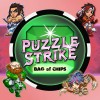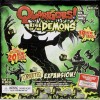drag badge here
Akvo
gamer level 2
483 xp
483 xp
followers
1
1
Use my invite URL to register (this will give me kudos)
https://boardgaming.com/register/?invited_by=akvo
profile badges
...
...

recent achievements

Rated 10 Games
Rate 10 games you have played.
Rate 10 games you have played.

Critic - Level 1
Earn Critic XP to level up by completing Critic Quests!
Earn Critic XP to level up by completing Critic Quests!

It's All About Me
Edit your Gamer Bio via the "edit profile" page.
Edit your Gamer Bio via the "edit profile" page.

My First Game Tip
Submit a game tip, strategy, or house rule.
Submit a game tip, strategy, or house rule.
Player Stats
Critic (lvl 1)
120 xp
120 xp
Explorer (lvl 0)
86 xp
86 xp
Professor (lvl 1)
132 xp
132 xp
Reporter (lvl 0)
72 xp
72 xp
About Me
Hello there! My name is Akvo and I've recently gotten into this thing called 'board gaming', thanks to the board gaming club at my school. Expect to see reviews and tips from me!






















Quarriors!
[This is a tl;dr review. While the whole review is extensive, you may read the last paragraph for the overview of my impressions.]
Quarriors! is not just a game where the developers tried to stuff as many ‘Qu-‘ words in its lingo as possible. It is also a fun, light game that makes for great filler. And as much as many gamers would hate to admit it, rolling dice is pretty darn fun.
The premise of Quarriors is simple. You are one of the eponymous Quarriors, a wizard with the ability to harness Quiddity to summon Quarry–magical creatures and mystical spells that help you do battle. The goal of the game is to obtain glory for the Empress (not Queen?) Quiana before your rivals do the same.
The base mechanic of Quarriors is deckbuilding–or more accurately, dicebuilding. Naturally, this means that, instead of building up a deck of cards, you build up a pool of dice. To do so, you draw dice from your bag, roll them, and play them.
Setting up is pretty easy, and similar to determining the bank of Dominion, for example. A set of cards denoting creatures and spells are shuffled; seven creatures and three spells are drawn. The dice that are associated with these are put in the center of the play area, along with three cards that are common to every game. These are the ‘Wilds’ and represent the Quarry available for you to capture on your turns.
Like in all deckbuilders, you also start with a set of pretty bad dice.
On your turn, any creatures that survived the previous turn are ‘scored’. This means they award you with a certain amount of Glory points and are discarded. Then you draw six dice from your bag (replacing your discard pile into the bag if you need to draw more) and roll them. You may ‘spend’ these dice to gain the effect on the top face. There are several effects you can roll:
*Quiddity, the currency of the game. You can spend this to gain that much Quiddity for later use.
*Creatures, the linchpin of the game. You must spend Quiddity to summon them; they give you points on the next turn and attack your opponent’s creatures to prevent them from doing the same.
*Spells. Depending on the exact spell that you’re using, you can either spend it to immediately gain some sort of effect, or equip it on a creature for later effect.
After spending your dice for your actions, any creatures you have immediately attack your opponents. Battle resolution is simple; you add up all the offense of your creatures to get your total attack, and your opponents defend against your attack one defender at a time. If the creature a defender chooses has more defense than the total attack value, then the attack is successfully blocked. But if that creature has less defense, it is destroyed and your opponent’s attack strength decreases by that number. It’s not easy to explain in words; it’s most similar to the trample mechanic in Magic: the Gathering.
After attacking, you may choose to use any leftover Quiddity to capture a die from the Wilds. You discarding any unused dice, then your turn is over.
The rules of Quarriors are quite easy to grasp–well, they would be if the rulebook didn’t use so much weird terminology. The dice immediately available for you to use (the analog of a hand with cards) is referred to as your ‘Active Pool’; summoned creatures and prepared spells are put in the ‘Ready Area’, and discarded dice are placed in the ‘Used Pile’. Once you remember this strange terminology, though, the rest of the rules will click in place.
On to the components. The tin where the game is stored is absolutely beautiful. It looks like one of the dice in the game; I’ve heard that different tins have different dice on them. The cards feel strong and able to withstand several games, and the art on them is gorgeous. You get Standard Eurogame Cubes for marking score and four dice bags to serve as your ‘deck’.
The dice in the game are pretty small. There are more than one hundred dice in the box, so I assume they’re kept at this size to keep them cheap. I’ve noticed a few of the face have some paint defects, although nothing that makes a die completely ambiguous. Barring that, though, the dice are nice to look at; each class of creature or spell is represented with a different die. The Quake Dragon is a brown mottled die, for example, whereas the Scavenging Goblin is a stark green.
When playing the game, my group and I have noticed that the game goes by way too fast with the suggested point scores. I know this is a filler-type game, but it’s a bit frustrating when the game goes by too quickly–after all, you don’t really know whether the decisions you made are the right ones!
Luck is also a big part of this game, which is inherent due to the dice. Naturally some dice are better than others, but again, you don’t always feel like you’re synergizing dice together like cards in Dominion.
This game is one of the few games I actively house-rule. Generally I play to twice the Glory recommended by the game. This does increase the feel of strategic depth a bit, and makes the game go on for just the right amount to be the perfect filler.
[tl;dr] Quarriors! is a fresh variation on the deck building mechanic. While I had some issues with the dice being kind of small and some minor paint issues, the game itself is fun and fast-paced. It’s certainly not as deep as Dominion, Ascension, or Thunderstone, but its simple mechanics and the sheer fun of rolling dice make it a great filler game.